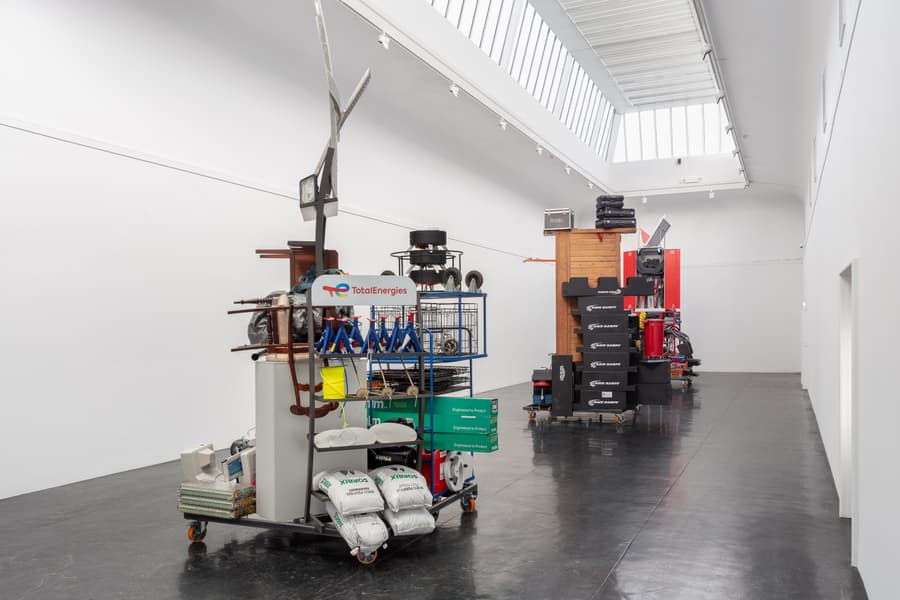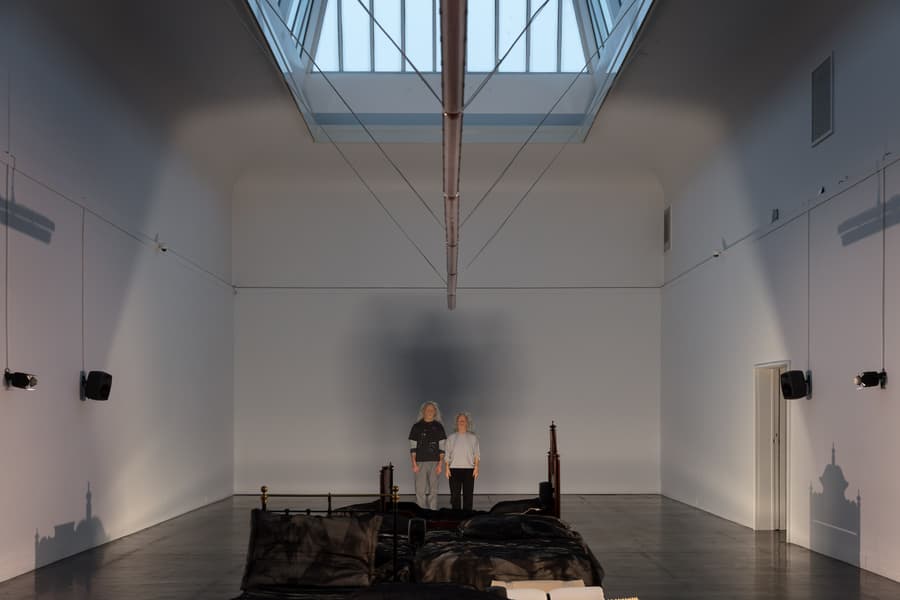Hold\
05.06.25 – 30.07.25

The Master's students in Fine Art at the Oslo National Academy of the Arts present their graduation projects in a joint degree exhibition at Kunstnernes Hus. The exhibition spaces include the foyer, the restaurant, the reception area, the lower gallery, the cinema and the Academy Room, 'Pakkerommet', the loft at the back of the building, as well as the corridors.
About the exhibition
“Statens Kunstakademi” is written above the entrance at the back of Kunstnernes Hus, a trace from when the art academy was once housed here. The entrance is currently held up by two load-bearing metal rods.
With this image in mind, we—the graduating Masters of Fine Art class at the Oslo National Academy of the Arts—entered into a conversation about support structures. What it means to be present, even when uncertain. Scaffolding became a way to think: not only as a thing that holds, but as a skin\a covering\a temporality\a signal of something unfinished.
The graduation exhibition combines diverse practices ranging from fictional audio guides and large scale paintings, to 35 mm slide projections of permafrost. An exhibition architecture of building materials – netting, plastic, rods from scaffolding – connects the work of the 19 artists, as they attempt to navigate the labyrinthine spaces of Kunstnernes Hus.
During the exhibition period, there will be a screening program, performances, as well as a newspaper publication. The exhibition has been curated collectively in dialogue with Professor Lisa Rosendahl.
See the floor plan:
Get the newspaper that was published in connection with the exhibition:
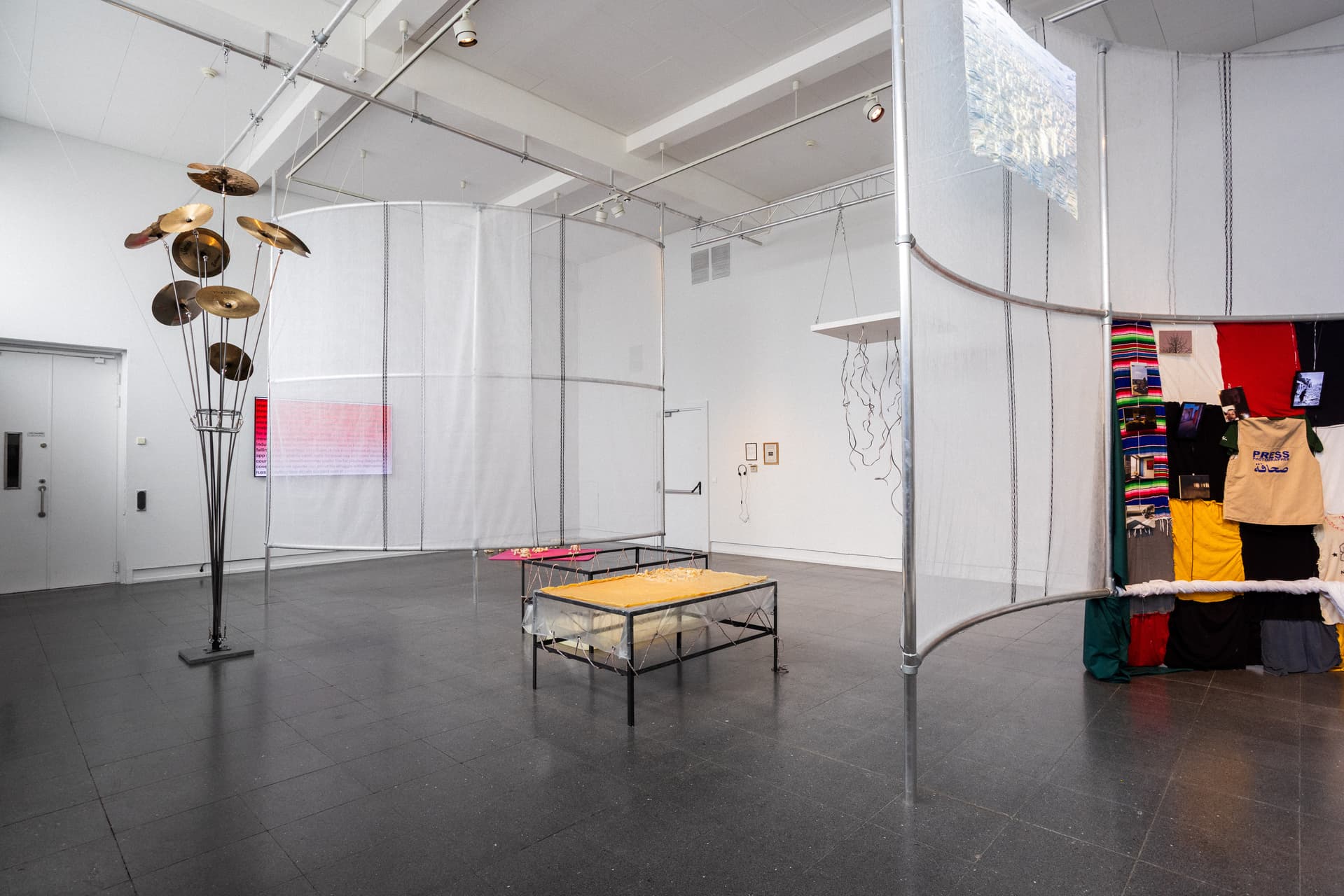
Photo: Studio Abrakadabra. Courtesy of the Academy of Fine Art. 


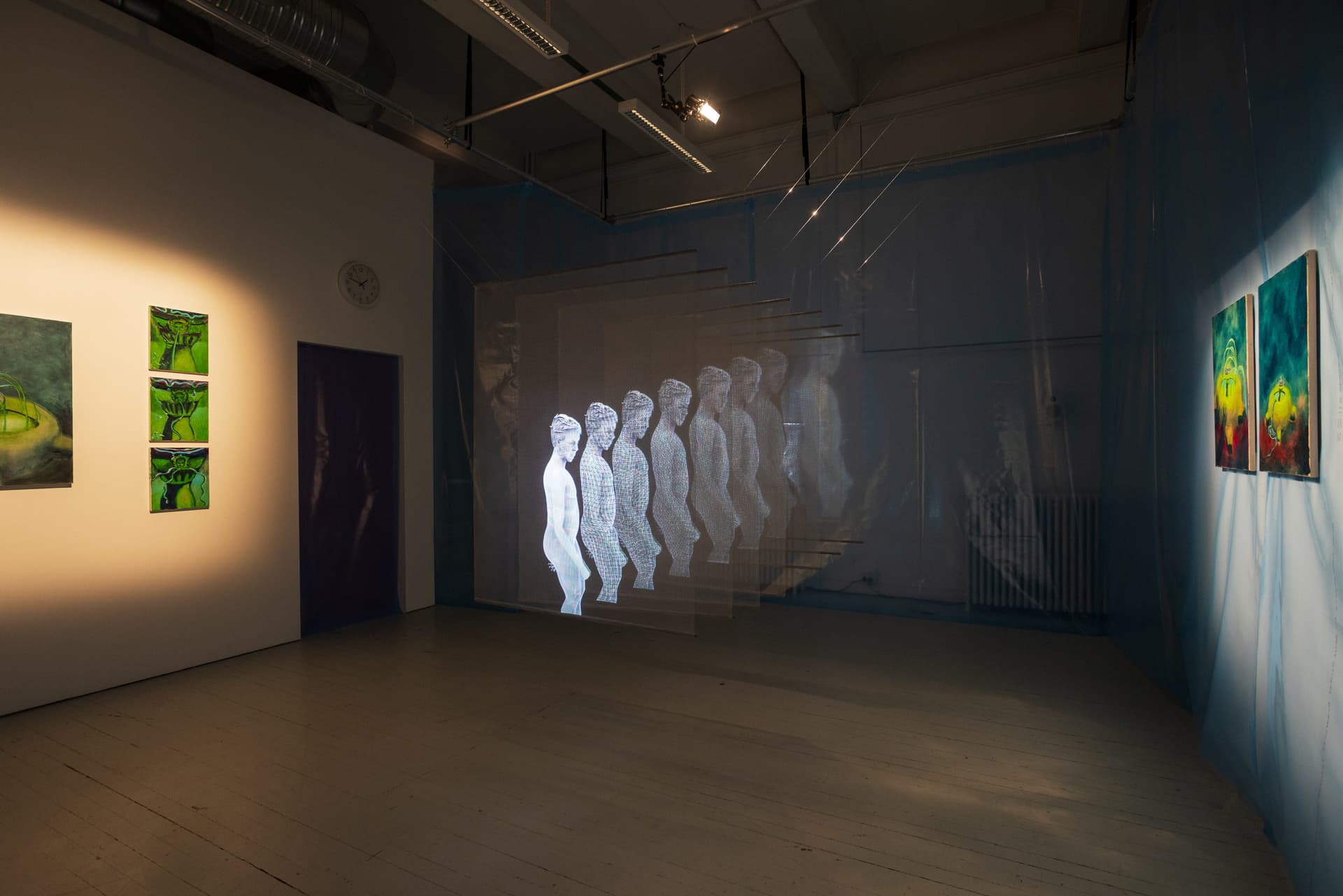
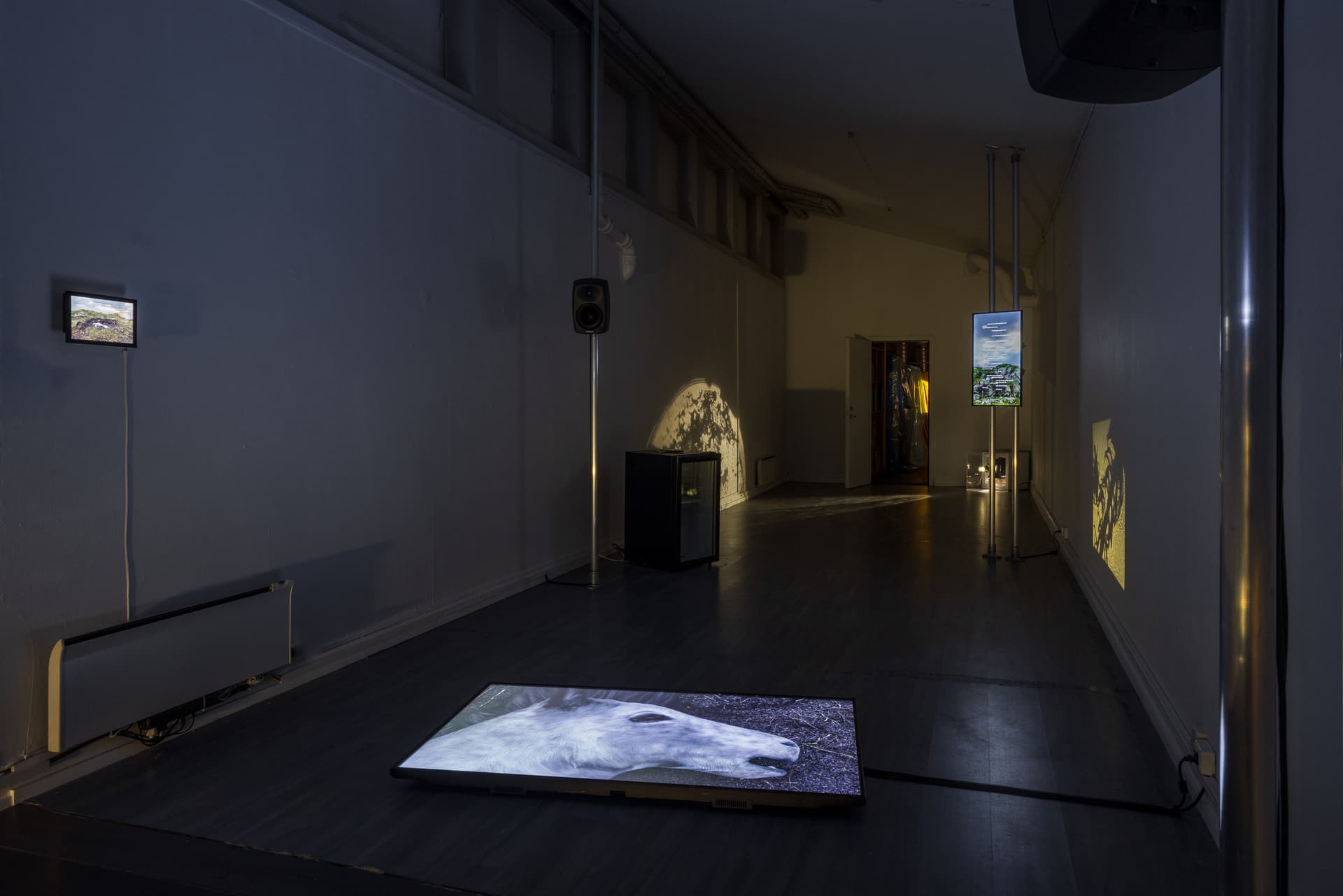
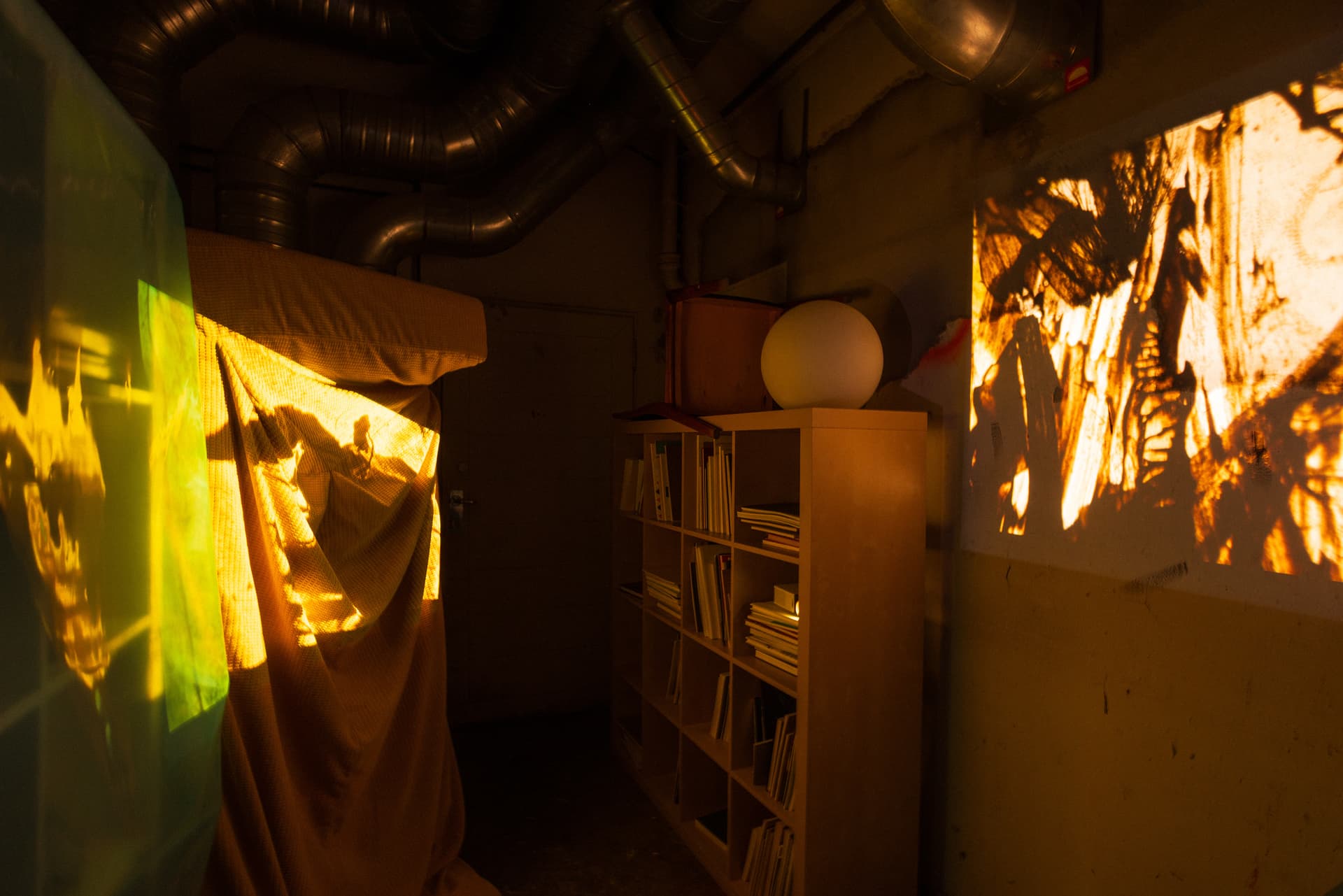
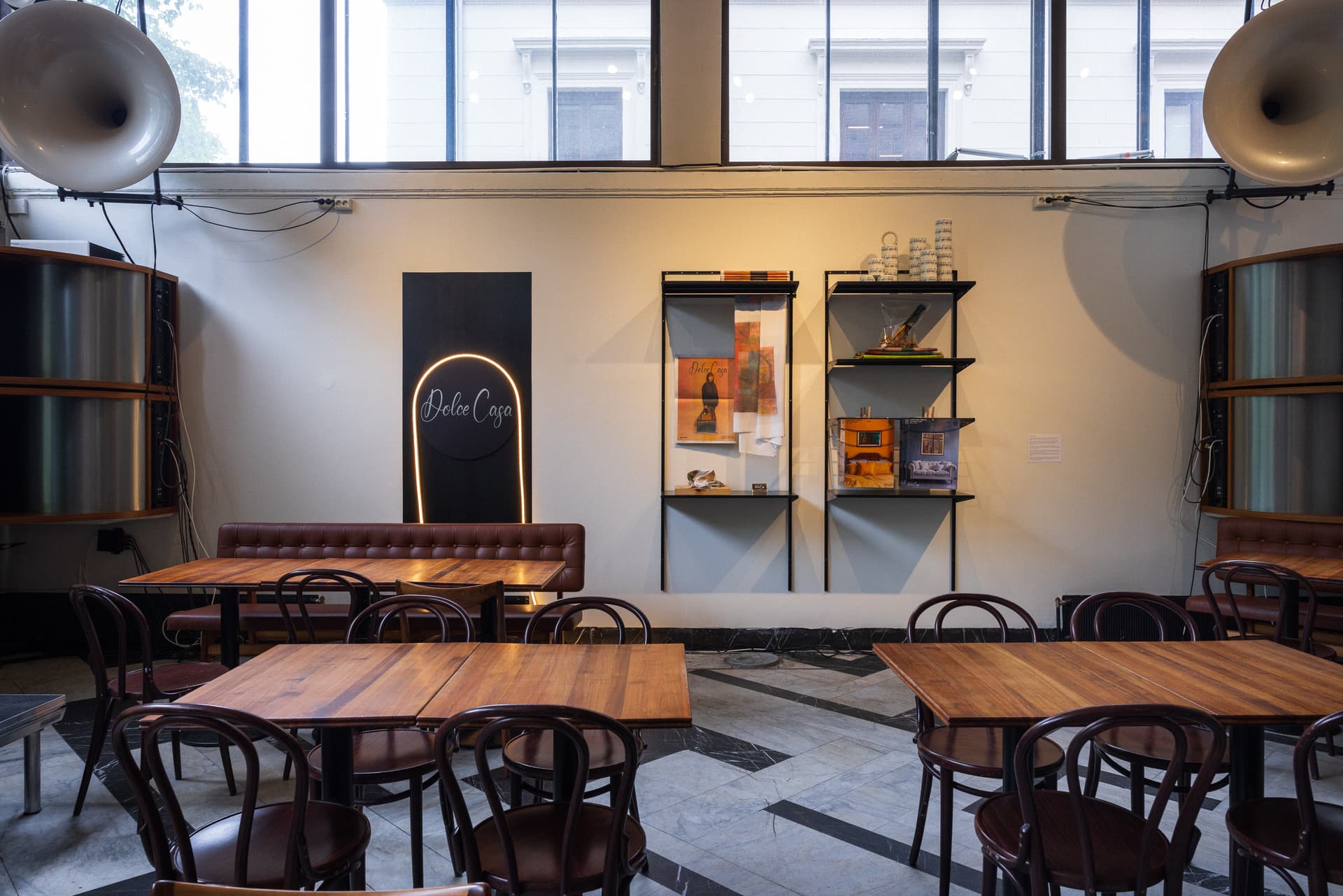
Participating artists and list of works
Carmel Alabbasi
Carmel Alabbasi is a multidisciplinary artist working with photography, video, sound, experimental film, installation, and sculpture. With a background in journalism, social anthropology, and fine art, their practice blends critical research with material experimentation. Alabbasi's work explores themes of absence, disappearance, and systematic erasure, tracing how bodies, places, identity, and collective and personal memories are shaped by colonial and patriarchal violence in Palestine.
Exhibited work:
The Architecture of Ambiguity, 05.06-30.07.25. The hallway from the cinema to the Academy's Room.
Composed of cement, plastic, and steel, this installation emerges from a shared vision with Gaza-based artist Mustafa Mohanna. We wonder: What becomes of walls when they take the shape of the bodies they subdue? When the apparatus claiming to “shield” reveals itself as an engine of suffocation for the fragile and sustenance for the dominant? Bureaucracy cloaks itself in the guise of order yet beneath it lie profit, entitlement, and quiet complicity.
Step inside. Read the fragmented notes. Let one travel with you home.
Later, in solitude, return to it: does meaning persist when the its context has vanished?
Victoria Alstrup
Victoria Alstrup (b. 1994) lives and works in Oslo, Norway. She holds a Bachelor degree in Fine Arts from the Oslo National Academy of the Arts (2023) and is currently pursuing a MFA at the academy.
Exhibited work:
Dolce Casa: A Shelving System of Art, Leisure, and Luxuriation + Brugata: The Making of HIWTAI + Dolce Casa Entrance + Pepperoni by Dolce Casa + Dolce Casa ad, 2025
Dolce Casa is a conceptual art project by Victoria Alstrup, presented as a fictional company in the 2025 graduation exhibition at Kunstnernes Hus. First founded during the HIWTAI – Home Is Where the Art Is
project in Brugata, Oslo, and continues to develop. The project also lives on through Instagram: @dolcecasastudio_.
In the exhibition, Dolce Casa appears in many forms: a shelving installation in the restaurant area, a film screening, ephemera (like Dolce Casa sticker-tickets), a pizza-based work at Lofthus Samvirkelag, and a printed ad in the exhibition's publication.
"Dolce Casa encourages buyers to ‘Stay inspired’ while promoting ‘Timeless elegance’ for their homes" (Live Drønen, Hulias, 2025). Alstrup describes herself as both the founder and the featured artist, blending systems of development, maintenance, circulation, and redistribution.
Asked why she self-exploits through such a corporate persona, Alstrup calls it an experiment — embracing internalized labor conditions to explore the structural conditions tied to art’s market viability, visibility and metrics.
Rather than resisting commercial frameworks, she integrates them. Dolce Casa becomes both artwork and metamorphic structure — a self-defining, hybrid platform through which she investigates market dynamics, symbolism, and potential future collaborations.
Vilja Houen Askelund
Vilja Houen Askelund is an artist from Stavanger who lives and works in Oslo. In her practice she is interested in teenageness as a cultural phenomenon: how we understand and relate to the world as teenagers. She does sculptures and works with textile, clay, objects and collages. Askelund holds a Bachelor's degree from the Academy of Fine Arts at the Oslo National Academy of the Arts and is currently finishing her MFA.
Exhibited work:
Gotta fight, fight, fight, fight, fight for this love, 2025. Glazed ceramics and gym mat.
"Gotta fight, fight, fight, fight, fight for this love is a series of androgynous miniatures performing ambiguous embraces.
The sculptures come mainly from two images that have stuck with me: a child’s twisted revenge fantasy come true from the short story “Sardines” (Kristen Roupenian) and a Brazilian jiu-jitsu practice training I witnessed. What fascinated me with the latter was how ritualistic and performative the changing of fighting partners became. Like a series of choreographed dances where different bodies merged and separated. It became impossible for me to grasp who was winning. Or if that was even the point.
On the 7th of June and the 12th of July the collaborative performance I love it when you hold me close II with Vilja Houen Askelund and Benjamin Hsieh will be staged in the exhibition.
Thank you to the lovely people at Grip Gym."
Åsa Båve
Åsa Båve (b. 1988) is an artist and filmmaker based in Oslo and Gothenburg. She works with installation, sculpture, performance and video. Her work is rooted in maintenance, care, and vulnerability. She is particularly drawn to materials that carry bodily and everyday associations. During her master’s studies, she has explored soap as a living and ephemeral material. Her work has been exhibited in Aarhus Kunsthall, 3:e Våningen in Gothenburg and at Southern Sweden Design Days in Malmö. She was also part of the group show Caring Futures in collaboration with the University of Stavanger (UiS) and artist and curator Hege Tapio.
Exhibited work:
Leaking Body I & II, 2025. Handmade soap gently placed in water, the remnants of a soap fountain, two bedlike structures of metal, plastic sheets tied down with soap-covered ropes.
On the metal bed lies a skin made of soap, it stretches across the frame. The second frame is filled with a soap in water that slowly dissolves, merging with its surroundings, a changing body. Soap is a material in flux—disintegrating, reforming, restoring. It visibly gives of its body to care for another.
The work presents two stages of the same process: one in dissolution, the other regenerated. Over the course of the exhibition, the two bodies will slowly shift and alter from liquid to solid, from firm to hardened.
Kim Andreas Roland Berger
Kim Andreas Roland Berger (b. 1993, Oslo, Norway) lives and works in Oslo:
"I work with series of paintings and wooden sculptures. My process begins with drawing in the early morning, before the mind has fully awakened. The compositions are rooted in the architecture and natural surroundings of my family farm, art historical references, and a contrast between geometric surfaces and flowing organic forms. The works reference fragmented pictorial spaces, with stacks of paintings reflecting the way artworks accumulate over time along the walls of my studio."
Previous education includes: Einar Granum School of Fine Art (2017–2019) Bachelor of Fine Art, Oslo National Academy of the Arts (2020–2023) and the Hungarian University of Fine Arts, Budapest (Exchange program, 2024).
Exhibited workw:
Accumulating Stacks, 2025. Paintings of variable sizes, acrylic and oil on linen canvas.
"My head is like an old computer with many tabs open at the same time. The rows of tabs I’ve saved to look at another day grow longer and longer. They mostly consist of old paintings I’ve made, along with paintings I want to make when I see Mamma Karin Anderson or Jonas Wood. If I pull the tabs too quickly, the image echoes and repeats across the screen.
The works are based on drawings I make in the morning before my mind has fully awakened. The painting begins with raw pigment and acrylic mixed with lots of water. The paint flows effortlessly on the marble-primed linen canvas. With oil paint, thicker and more opaque strokes are added to frame the fluid areas."
AccumulatingEcho, 2025. Oak sculpture with acrylic and oil painting.
The sculpture consists of wooden shapes cut on a bandsaw, assembled during the process of painting Accumulating Stacks. It's a translation of the colours and shapes in the paintings into a physical wooden structure.
Thyra Dragseth
Thyra Dragseth (b.1993, Copenhagen) is a Norwegian artist based between Oslo and Lisbon. Dragseth works multidisciplinary with photography, film, sound, text, and installation. Her practice is rooted in feminist ideology. It is preoccupied with investigations of societal roles, and inter personal, and professional relationships. Leaning on autobiographical traditions, her work critically engages in questions of truth and perception. Dragseth co-initiated the discursive curatorial project Lars Lisboa (2021-2023), hosting events and exhibitions. Recent solo and group exhibitions include; Candyland, Stockholm (2025); Gallery K4, Oslo (2025); Pachinko, Oslo (2024); OSTRA Practice, Lisbon (2024); Kristiansand Kunsthall (2023); Sol Nexø, Bornholm (2023), and MELK Gallery, Oslo (2021).
Exhibited work:
Child, 2025. Video Installation. Full HD, sound, sheets of aluminium mesh, steel tubes, fish wire, spray paint.
Child is a moving light sculpture accompanied by a melody, combined with the sounds of a ticking clock. Through images organised in a stop motion like animation, a two-faced golem figure appears isolated against a black surrounding. The figure, trapped in an eternal repetitive loop of running forwards and backwards, is projected onto seven layers of thin aluminium mesh where parts of the image are inevitably lost. Their face, split in two, stems from 3D scans of the faces of the artist’s son and father, encapsulating the two in one body, seeking resemblance between generations. The projection is repeated onto each layer, like possible worlds with possible lives, belonging to the past and the future. The translucent qualities of the materials making up the screens enhance the presence of the imperceptible; like a pattern you cannot escape; or trauma stored in muscle tissue; or a developing disease.
Elise Dypvik
Elise Dypvik is a contemporary artist based in Oslo, currently completing her MFA at the Oslo National Academy of the Arts. Working primarily with multimedia installations that blend sculpture, sound, video, and performance, she explores the tension between digital and physical realities. Her practice investigates the psychological effects of modern life, focusing on how memory, emotion, and human biology interact with a rapidly evolving technological world. Influenced by science fiction, video games, and natural landscapes, Dypvik constructs speculative scenarios and imagined futures that reflect on existential questions and the feeling of alienation in contemporary society.
Exhibited work:
Echoform, 2025. Textile, LED-lights, ping-pong balls, arduino, movement sensor.
Placed high and out of reach, the work is activated only when someone approaches. A textile creature responds with light—a wordless and immediate reflection of bodily movement. It sees you the moment you discover it.
We are experiencing an increasing synthesis of the organic and the technological. But where, exactly, do we draw the line between information and consciousness? When an electronic structure responds to our presence, are we witnessing a diluted form of subjectivity - or the contours of a new, unfamiliar kind of presence?
Signe Greve
Through sculpture, installation, and performance, Signe Greve explores the dynamics between anxiety, nature, and human vulnerability. She approaches these themes through the concept of hosting, using it as a metaphor to examine the relationship between order and chaos, trust and control.
Greve is fascinated by hosting as both a physical and psychological space for comfort, and as an image of the tension between security and insecurity. She explores this ambivalence through material research and positioning. In her practice, Greve works mostly with organic and self-developed materials, as this is important both sustainably and conceptually for her work.
Exhibited work:
ERP (exposure and response), 2025. 9 insulation boards of organic wood fibers, polyester, mattress foam, paper maché.
ERP (exposure with response prevention) is a cognitive behaviour therapy confronting the thoughts, images, objects and situations that gives one anxiety or provokes one’s obsessions - making someone feel uncomfortable. This confrontation, in practice aims to identify patterns of behaviour to retrain the brain to no longer see the triggers as a threat.
This installation has developed from a material research, aiming to emphasize the internal or invisible. 9 insulation boards take shape as a stage or grid for the sculptures to unfold. The sculptures consist of paper maché, polyester, mattress foam; materials that would normally be covered or enclosed. Each individual sculpture placed on the boards has its own kind of self reflecting/self mirroring shape to them. In their fragility, they are placed on the grid, open for potential development.
Lova Hiselius
Lova Hiselius (b. 1997, Stockholm) is a visual artist based in Oslo. She works interdisciplinarily with painting and installation. Through phenomena such as the Shadow, the Ghost, the Imprint, and the Reflection, she explores the boundaries between presence and absence in carefully chosen motifs. By creating works that blur the line between imagination and reality, she investigates how emotions such as fear and longing can manifest in physical form. In recent years, she has participated in exhibitions at Liljevalchs (Stockholm), Billedkunstnerne i Oslo, Oslo Kunstforening and Podium. Hiselius was one of the participants in the OsloCity#12 summer residency at Podium, and her MFA graduation project was exhibited at Centralbanken.
Exhibited work:
Repetitions Based on a Fountain Seen Twice, 2025. Oil on canvas, variable dimensions.
On the edge of an old town is a fountain overlooking the river. The usual effect of a refreshing fountain is disrupted by an unsettling green hue. Observed near the river’s cold, clear flow, the fountain appeared trapped in a closed circuit. This series of oil paintings lingers in the gap between the actual place and the fantasy shaped around the memory of it. Each canvas traces the imagined moment when the water breaks free from its controlled loop, detaches from its mechanical origins, and gradually aligns itself with the flow of the river. Presented in variable dimensions, the motif is repeated compulsively, as an attempt to animate the fountain.
Mohamed Jabaly
Mohamed Jabaly is an award-winning Palestinian filmmaker and producer from Gaza City, whose documentaries capture his homeland’s resilience and spirit. His latest film, Life is Beautiful – Al Haya Helwa earned global recognition and numerous awards, including the Best Directing Award at IDFA 2023 and the Best Nordic Documentary at Nordic Panorama 2024. His previous award-winning documentary, Ambulance (2016), screened at major festivals and continues to resonate worldwide.
Dedicated to fostering talent, Jabaly spent a decade leading film workshops in Gaza before moving to Tromsø, where he now manages the TwinCity program at Tvibit. As a key member of the Palestine Film Institute, he oversees festival delegations and manages the Palestine Documentary Hub. Mohamed has served on juries for festivals including IDFA, One World, and Nordic Panorama. Jabaly holds a B.A. from Nordland Film & Art College and is completing his M.A. at Oslo's National Academy of Arts.
Exhibited work:
MY TENT IS NOT A SHELTER (EXTRACT), 2025. Collaged and stitched clothes, 4 looped videos on screens.
"A tent, designed as a temporary shelter, becomes a fragile refuge during the genocide in Gaza, offering no safety from the biting cold of harsh winter nights or the threat of falling bombs.
My wall installation reflects this reality, embodying both resilience and fragility. This fabric wall has been extracted from a previous iteration of the work, which consisted of a whole tent made from pieces of my own clothes, stitched together by hand. The four screens document different moments from my life in Gaza over the last two years. This delicate structure – now part of another ephemeral structure, the scaffolding – expresses my experiences over the past two years as I bore witness to my family's struggles from afar. It also serves as a powerful symbol for my people, who are still living in tents over the rubble of their destroyed homes.
As I write this, the genocide in Gaza continues. Our loved ones—families and friends—are forced to live in unsafe shelters. With no protection, these temporary homes consist of tents lining the streets, with the sky as their roof and fragile fabric as their doors."
David Tobias Bonde Jensen
David Tobias Bonde Jensen (b. 1988) is a Danish artist living and working in Norway. Jensen’s work explores speculative, spectral and more-than human bodies—bodies migrating between fiction, reality and different scientific paradigms, caught between different narratives. By playing with the performative possibilities and poetic potentialities of animated media, special effects, sound design and song, Jensen attempts to give these sometimes silenced and misconceived bodies a presence, a voice and a space where they can tell their stories, whether they are animal, alien, dead or something in-between.
Exhibited work:
Dragon (silence and spit), 2025. Screens, speakers, animated video, text, sampled flute and recorded vocals. Duration: 6:59 min. With help from Lars Hemmingsen Nørgaard / 3D Service and artist Kim Laybourn.
Dragon (silence and spit) is a video and sound installation centered around a collapsed chimerical creature in an unknown landscape. From the being’s empty eye emanates a song about its own unmaking.
The scene draws on the artist’s upbringing among icons of saints painted by his father, especially those depicting Saint George's battle with the dragon. Here, the saint is absent; instead, his horse and the dragon-snake have fused into a hybrid figure.
The song is partly inspired by Ursula K. Le Guin’s idea of the mother tongue as “a language always on the verge of silence and often on the verge of song.” The text is written and performed from the perspective of the chimera, as a fragmented search for words, a struggle with a vocabulary organized around the human subject, a song navigating language and silence.
George McGoldrick
George Seamus McGoldrick (b. 1995, London) currently lives and works between Oslo and Kent, United Kingdom. His most recent series of works titled Starter-packs looks at ways in which the promise of a new outdoors hobby or the deeper knowledge of your family history is available for both production and purchase online.
Exhibited works:
Gresford, 2025. Pencil on paper. 21 x 29.7 cm.
You've heard of the Gres- ford dis- as- ter, Of the ter- ri- ble price that was paid, Two
Hun- dred and for- ty- two col- liers were lost, and three men of the res- cue bri- gade.
For Sale!, 2025. Pigment on paper. 30 x 48 cm.
Flugelhorn case. Black leather exterior and brown velvet interior, dimensions 12 x 13 x 114cm. If interested please contact: Gerrit Dou +47 918 62 042.
Air-powered!, 2025. Pigment on paper. 28.2 x 43 cm.
From the advent of brass instruments to the use of a turbo-charger in modern petrol engines, on Sunday June 15th, 2025 Jan Stein will be giving a talk about all things ‘air-powered’. The talk lasts approx. 40 minutes. Refreshments will be provided.
David Noro
David Noro (b. 1993, DK/ITA) is a visual artist based in Oslo and Copenhagen. He studied Fine Arts at the Gerrit Rietveld Academie in Amsterdam (2014–2018) and is currently pursuing an MFA in Fine Arts at Oslo National Academy of the Arts (2023–2025).
Primarily a painter, Noro also works across collage, drawing, textiles, and sculpture. His practice is rooted in a personal archive of words, texts, songs, and conversations, through which he filters fragments of the everyday. These fragments are translated into layered compositions where narrative traces flicker in and out of focus, shaped by mark-making and material exploration.
Central to his painting is the gaze—the one that looks, and the one being looked at. Noro's works hold a quiet tension between presence and distance, where images unfold with a momentary, relational sensibility. Motifs arise intuitively, shifting between the poetic and the prosaic, without settling into fixed meaning.
Exhibited works:
Critters quarrel at night, 2025. Tempera, egg-tempera, ink, aquarelle, acrylic, pigment on canvas. 214 x 366 cm.
Notes on a crowd (2022-2025), 2025. Egg-tempera, acrylic, oil, acrylic, collage, ink, Alcohol-based ink, sealant, pencil on wood, linen, cotton and canvas. Dimensions variable.
Drifting between dream and waking, these works evoke quiet, symbolic spaces shaped by subtle psychological undercurrents. A central theme is transformation: of self, perception, and memory. Instead of linear narratives, each painting suggests an emotional or psychological state in flux.
One painting recalls a poorly prepared night by Roskilde Fjord, brimmed with imagined threats. Another mourns the loss of a friend; a third brings to life a restless kitchen inventory at night.
The paintings can be seen as images of forgetting, where layers create a paradox: the more that is hidden or painted over, the more the work emerges. It’s about constant change and a balance between the visible and invisible, the known and the forgotten. Like that night, forms become ambiguous and silence holds unspoken threats. The paintings open a space between presence and absence, memory and forgetting. Sometimes, the viewer becomes the observed in a game of position and perspective.
May-Oisín Qviller
May-Oisín Qviller (b. 1995) is primarily a filmmaker, while also working with sound, music, photography and writing. His work explores the way we perceive and understand the world, especially those of us who aren't able to find a spoken or written language to clearly communicate to others how we feel and why. With this interest, the extreme sides of human behaviour are often explored, like trauma, violence and hatred. However, most of his works try their best to appear as songs, to create a language that appears accessible, child-like and curious.
Exhibited work:
While Passing, It Grows, 2025. Multichannel sound, digital projections.
While Passing, It Grows is a restless sound installation, a child-like destruction of someone's memory, with small digital projections that guide you through the room's dark and narrow space.
Klara Josefin Rosenlund
Klara Rosenlund (b. 1991) is a Swedish artist based in Norway, holding a BFA from the Art Academy in Bergen and an upcoming MFA from the Oslo National Academy of the Arts in 2025. Her work has been exhibited at venues including Vent Space in Tallinn, Gyldenpris Kunsthall in Bergen, and Halmstad Konsthall in Sweden. Her practice often revolves around themes of vulnerability, threat, and emotional tension fields.
Exhibited work:
Stretch, 2025. Hand-bent sharp steel rods shaped in organic forms, motor. 100 cm x 100 cm x 250 cm
This sculpture consists of steel rods organically shaped, hanging from the ceiling, with sharp tips stretching towards the ground. The work continues an exploration of spikes and sharp forms as symbols of protection during times of inner uncertainty.
Sondre Røe
Sondre Røe (b. 1993, Harstad) works across painting, photography, film, and digital media in a multidisciplinary practice focused on identity and attention. Recent exhibitions include Mikey Laundry Art Garden (Bergen), Kunstnernes Hus (Oslo), Saksumdal Tempel (Lillehammer), Nitja (Lillestrøm), and Salgshallen (Oslo).
Exhibited work:
zero-views.no, 2024–, generative website in continuous transformation. Built with HTML, CSS and collected RSS feeds.
An exploration of how attention is shaped, fragmented, and redirected in a digital landscape. Through a generative text stream, it reflects the rhythms of online culture—where information competes, overlaps, and dissolves.
Taylor Alaina Liebenstein Smith
Taylor Alaina Liebenstein Smith (b. 1993) is an American, French-naturalized visual artist. She understands the climate crisis as a crisis of perception, and thus capacity for affect. With this in mind, she attempts to cultivate attunement and emotional sensitivity to seemingly dead or distant geobiological entities like permafrost or biofilms. To do this, she collaborates with scientists, poets, dancers, architects and other species, deconstructing perceived boundaries between scientific and artistic knowledge. Materially, her practice explores the poetic intersections between analog and biological media, blending bioart with film and video, installation, performance, sound, photography, printmaking and text. She holds an MA in Cultural Mediation from the École du Louvre and a BFA in Painting and BA in Art History from Boston University. Her work has been exhibited in France, Norway, Finland, Germany, Spain, and the U.S. A member of the Finnish Bioart Society, her works are also included in French National Collections.
Exhibited works:
Industrial era permafrost: -20°C, 1899, 2025. Sculpture, 55 x 49 x 81 cm.
This sculpture is part of a larger project exploring the poetics of permafrost through analog technologies. It is composed of a magic lantern from 1899 held inside a freezer, which has been transformed into a projectional vitrine. Inside of the magic lantern is a sample of permafrost, projected outwards. Permafrost is ground that remains frozen for two or more consecutive years, but is thawing due to human-induced climate change. This sample is one of many taken by the artist and geoscientists Mats Ippach and Anfisa Pismeniuk in Finnmark during field research carried out by the University of Oslo. Despite the -20°C temperature inside the freezer, the sample’s thaw cannot entirely be stopped. Hence, the projection continues to move throughout the exhibition.
Industrial era permafrost: 0°C and rising, 1965, 2025. 35mm slide projector with a carousel of 80 slides. 26 x 26 x 9 cm.
The 35mm slides held in this projector’s carousel contain no photographic film, but rather material samples that have been chosen and manipulated by the artist, and repeatedly frozen and thawed. In addition to permafrost samples, some slides also contain microbes cultivated from permafrost and thermokarst pond (thawed permafrost) samples, all taken in Finnmark. Others contain mixtures of forever chemicals and human tears: potential sources of future permafrost. Every minute, the carousel rotates and a new slide (a sample sandwiched between two glass slides) is projected, thawing the sample, generating a moving, gradually disappearing image.
Sanna Sønstebø
Sanna Sønstebø (b. 1999) creates instruction and conceptual frameworks that develops into text, video, and performance. She works mainly with the everyday, and uses its patters and predictable outcomes as a space for exploration and play. She holds a BFA from Leeds Arts University (2019), and is currently undergoing her MFA at the Arts Academy of Oslo. She participated in exhibitions at the Akademirommet at Kunstnernes Hus is 2024, at Assembly House in Leeds, UK with the art collective We Didn’t Fancy in 2023, as well as the residency #23 Understanding Intelligence at Praksis in Oslo in 2022.
Exhibited works:
Departures (001, 010, 100), 2025
001_Departures, 05:00; audioguide, MP3 player with headphones, wood frames, Kunstnernes Hus exhibition catalogue from 1995.
010_Departures, 05:00; audioguide, MP3 splay with headphones, wood frames.
100_Departures, 05:00, MP3 player with headphones, wood frames, mind map.
Audio guides are usually used in large museums. They talk about the origins of the work, the artists behind them, and the time periods they were made. Audio guided tours are a form of storytelling. They tell us what we should pay attention to and why.
In Departures 2025, the visitor is invited to enter in to three narrated stories, placed in three different locations at Kunstnernes Hus, that frame the contents of this exhibition in three different ways. ‘Departures’ aims to explore how the information we are given about exhibitions, shape the way they are experienced; from the voice and patterns of the person speaking, to the stories they choose to tell us. These audioguides are based on the works in the room, but are speculative and fictional. They might not represent the artists' original intentions.
Isak Ree Torgersen
Isak Ree Torgersen (b. 1994, Oslo) is a multimedia artist working within the intersection of ambition and desperation. Through this bio, he attempts to convert aspiration into institutional legitimacy, shaped by audience influence and complicity. Consider this a plea to exhibit internationally or institutionally.
Exhibited works:
Bouquet of Flowers, 2025. Cymbals, steel rods, rim.
A bouquet never needs a reason.
Its symbols compose a mute severed gesture.
Percussions Play, 2025. Cymbal, steel rod, drumsticks.
The cymbal and the drumstick depend on each other. One strikes; the other responds.
Their tense, confrontational relationship is a clash of force and resistance.

